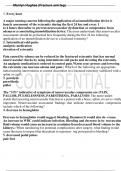NURSING 101 (Summary Summary Marilyn Hughes Age: 45 years Diagnosis: Lower Leg Fracture Complete Log.)
Chamberlain College Nursing
Here are the best resources to pass NURSING 101 (Summary Summary Marilyn Hughes Age: 45 years Diagnosis: Lower Leg Fracture Complete Log.). Find NURSING 101 (Summary Summary Marilyn Hughes Age: 45 years Diagnosis: Lower Leg Fracture Complete Log.) study guides, notes, assignments, and much more.
All 37 results
Sort by:
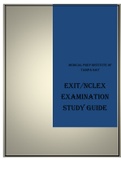
-
Exam (elaborations)
Exit and NCLEX Examination Study Guide
-
---158February 20232022/2023A+
- PriortyDefinitionDeciding which needs or problems require immediate action and which ones could bedelayed until later time because they are not urgentGuidelines for prioritizingNurse and client rank client's needsPriorities are classified as high, intermediate, or lowHigh priorities include life-threatening needsNonemergency and non-
-
$9.99 More Info
 lifesaver99
lifesaver99
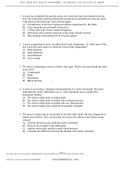
-
Exam (elaborations)
TEST BANK FOR HEALTH ASSESSMENT IN NURSING 6TH EDITION BY WEBER
-
---8May 20222021/2022A
- A nurse has completed the general survey of a client who has been transferred to the unit. The information gathered during the general survey primarily provides the nurse with which of the following? Select all that apply. A) An indication of the level of physical distress experienced by the client B) Clues about the overall health of the client C) A direct link to the client's medical diagnosis D) Indications about normal variations in the status of body systems E) Data relating to the ...
-
$13.49 More Info
 Havilah
Havilah
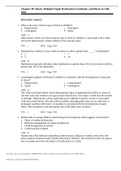
-
Package deal
NURSING 101Chapter 26: Sexually Transmitted Infections
-
---19March 2022
- NURSING 101Chapter 26: Sexually Transmitted Infections What unique factor causes adolescent girls to have a high risk for sexually transmitted infections (STIs)? a. They are in an experimental phase with sexual intercourse and believe they are resistant to developing STIs. b. The adolescent cervix is immature and lacks immunity. c. The length of th
-
$51.49 More Info
 Havilah
Havilah
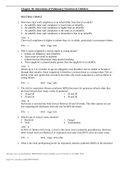
-
Exam (elaborations)
NURSING 101Chapter 36: Alterations of Pulmonary Function in Children
-
--9March 20222021/2022A+Available in bundle
- How does chest wall compliance in an infant differ from that of an adult? a. An adultÕs chest wall compliance is lower than an infantÕs. b. An adultÕs chest wall compliance is higher than an infantÕs. c. An adultÕs chest wall compliance is the same as an infantÕs. d. An adultÕs chest wall compliance is dissimilar to that of an infantÕs. ANS: A Chest wall compliance is higher in infants than it is in adults, particularly in premature infants. PTS: 1 REF: Page 1292 2. Why is nasal ...
-
$10.49 More Info
 Havilah
Havilah
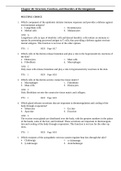
-
Exam (elaborations)
NURSING 101Chapter 46: Structure, Function, and Disorders of the Integument
-
--10March 20222021/2022AAvailable in bundle
- 1. Which component of the epidermis initiates immune responses and provides a defense against environmental antigens? a. Langerhans cells c. Keratinocytes b. Merkel cells d. Melanocytes ANS: A Langerhans cells (a type of dendritic cell) and dermal dendritic cells initiate an immune response by presenting processed antigen to T cells, thus providing a defense against environmental antigens. This function is not true of the other options. PTS: 1 REF: Page 1617 2. Which cells of the dermis r...
-
$10.49 More Info
 Havilah
Havilah
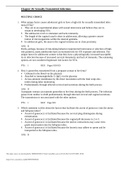
-
Exam (elaborations)
NURSING 101Chapter 26: Sexually Transmitted Infections
-
--9March 20222021/2022A+Available in bundle
- What unique factor causes adolescent girls to have a high risk for sexually transmitted infections (STIs)? a. They are in an experimental phase with sexual intercourse and believe they are resistant to developing STIs. b. The adolescent cervix is immature and lacks immunity. c. The length of the vaginal canal is short in adolescents, allowing a greater concentration of microorganisms within the internal genitalia. d. In adolescent girls, the anus to the vaginal introitus are in close proximi...
-
$9.49 More Info
 Havilah
Havilah
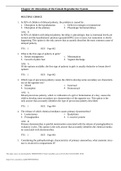
-
Exam (elaborations)
NURSING 101Chapter 24: Alterations of the Female Reproductive System
-
--8March 20222021/2022AAvailable in bundle
- 1. In 95% of children of delayed puberty, the problem is caused by: a. Disruption in the hypothalamus c. Deficit in estrogen or testosterone b. Disruption of the pituitary d. Physiologic hormonal delays ANS: D In 95% of children with delayed puberty, the delay is physiologic; that is, hormonal levels are normal and the hypothalamic-pituitary-gonadal (HPG) axis is intact, but maturation is slowly happening. This option is the only answer that accurately describes the most common cause of d...
-
$10.49 More Info
 Havilah
Havilah
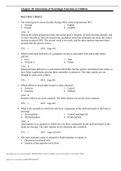
-
Exam (elaborations)
NURSING 101Chapter 20: Alterations of Neurologic Function in Children
-
--6March 20222021/2022AAvailable in bundle
- The neural groove closes dorsally during which week of gestational life? a. Second c. Eighth b. Fourth d. Twelfth ANS: B During the fourth gestational week, the neural groove deepens, its folds develop laterally, and it closes dorsally to form the neural tube, epithelial tissue that ultimately becomes the central nervous system (CNS). The second week is too early, and the other options represent times periods after the groove closes. PTS: 1 REF: Page 660 2. Which nutritional deficiency ...
-
$10.49 More Info
 Havilah
Havilah
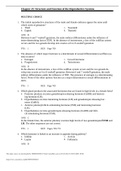
-
Exam (elaborations)
NURSING 101Chapter 23: Structure and Function of the Reproductive Systems
-
--9March 20222021/2022A+Available in bundle
- The initial reproductive structures of the male and female embryos appear the same until which week of gestation? a. Third c. Twentieth b. Eighth d. Thirtieth ANS: B Between 6 and 7 weeksÕ gestation, the male embryo differentiates under the influence of testes-determining factor (TDF). In the absence of testosterone, a loss of the wolffian system occurs and the two gonads develop into ovaries at 6 to 8 weeksÕ gestation. PTS: 1 REF: Page 769 2. The absence of which major hormone is a d...
-
$10.99 More Info
 Havilah
Havilah

